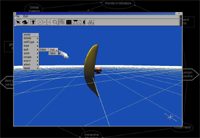Withindows: A Unified Framework for the Development of Desktop and Immersive User Interfaces (Dissertation Defense, Alex Hill)
October 1st, 2007
Categories: MS / PhD Thesis, Software, VR

About
Withindows: A Unified Framework for the Development of Desktop and Immersive User Interfaces
Prior 3D user interface research has been strongly influenced by the physical nature of a potential ultimate computer interface that can recreate all aspects of reality.
The focus of such research has not fully appreciated the differences between interactions that augment computational ability and those that seek to create a virtual reality. The result has been poor novice usability, low expert functionality, low object selection and manipulation efficiency and symbolic manipulation methods that are generally less efficient than their desktop counterparts.
The uniqueness of 3D interaction and first person space is frequently used to justify the shortcomings of such interfaces. However, a coming intersection between geo-referenced database information, ubiquitous networked devices and ubiquitous display technology promises to create an augmented reality that will extend traditional computing into the physical space around us.
The focus of this research is the belief that it is more likely that desktop applications will make a gradual transition into this space than it is that there will be a paradigm shift into using 3D interfaces The Withindows framework uses image-plane selection and through-the-lens techniques to create a single-authoring framework that optimizes the use of both traditional and immersive applications across transitional states such as desktop stereo, large-format displays and projector-based augmented reality. Because it is a generalization of the typical desktop fixed-viewpoint setup, image-plane selection allows head-tracking, stereoscopy and multiple DOF input devices to be added and removed as needed.
Image-plane selection can overcome ambiguity problems discouraging prior stereoscopic use by using a virtual cursor in the dominant eye and, thus, resolve non-linear control-display relationships inherent in some approaches to desktop stereo. When combined with through-the-lens techniques, image-plane selection allows immersive 2½D viewpoint management and object manipulation techniques analogous to those on the desktop that avoid scaling problems and restricted viewpoints.
This approach resolves global search and control-display scaling problems inherent in prior through-the-lens implementations and allows extensions for 6 DOF input devices that do not supersede the default interaction method.
The problem of fatigue can be significantly reduced by replacing typical immersive interactions out in front of the user with image-plane selection on windows floating below the hand. This thesis describes the Withindows framework, the development of a proof of concept virtual world builder, and a user study to validate some of the underlying assumptions it makes.
The user study found evidence that a dominant-eye cursor is well tolerated and that image-plane selection and ray-casting produce comparable levels of user fatigue and ease of use.
The desktop development application was evaluated over a full semester in a classroom environment, and the immersive application was evaluated in three separate projects by expert users.
Presentation and Defense:
Monday, October 1, 2007
11:00a.m. - 12:00p.m.